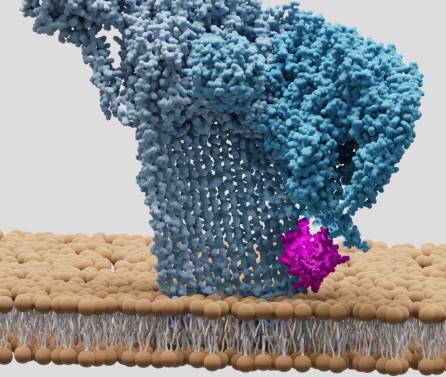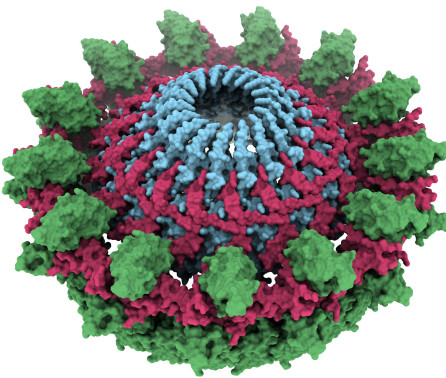Results
- Showing results for:
- Reset all filters
Search results
-
Journal articleBoehm M, Nield J, Zhang P, et al., 2009,
Structural and Mutational Analysis of Band 7 Proteins in the Cyanobacterium <i>Synechocystis</i> sp Strain PCC 6803
, JOURNAL OF BACTERIOLOGY, Vol: 191, Pages: 6425-6435, ISSN: 0021-9193- Author Web Link
- Cite
- Citations: 37
-
Journal articleWebb AJ, Karatsa-Dodgson M, Grundling A, 2009,
Two-enzyme systems for glycolipid and polyglycerolphosphate lipoteichoic acid synthesis in <i>Listeria monocytogenes</i>
, MOLECULAR MICROBIOLOGY, Vol: 74, Pages: 299-314, ISSN: 0950-382X- Author Web Link
- Cite
- Citations: 64
-
Journal articleHare S, Cherepanov P, Wang J, 2009,
Application of general formulas for the correction of a lattice-translocation defect in crystals of a lentiviral integrase in complex with LEDGF
, ACTA CRYSTALLOGRAPHICA SECTION D-STRUCTURAL BIOLOGY, Vol: 65, Pages: 966-973, ISSN: 2059-7983- Author Web Link
- Cite
- Citations: 10
-
Journal articleLiu Y, Garnett JA, Leon E, et al., 2009,
Detailed insights from microarray and crystallographic studies into carbohydrate recognition by microneme protein 1 (MIC1) of Toxoplasma gondii
, Protein Sci., Vol: 18, Pages: 1935-1947The intracellular protozoan Toxoplasma gondii is among the most widespread parasites. The broad host cell range of the parasite can be explained by carbohydrate microarray screening analyses that have demonstrated the ability of the T. gondii adhesive protein, TgMIC1, to bind to a wide spectrum of sialyl oligosaccharide ligands. Here, we investigate by further microarray analyses in a dose-response format the differential binding of TgMIC1 to 2-3- and 2-6-linked sialyl carbohydrates. Interestingly, two novel synthetic fluorinated analogs of 3'SiaLacNAc(1-4) and 3'SiaLacNAc(1-3) were identified as highly potent ligands. To understand the structural basis of the carbohydrate binding specificity of TgMIC1, we have determined the crystal structures of TgMIC1 micronemal adhesive repeat (MAR)-region (TgMIC1-MARR) in complex with five sialyl-N-acetyllactosamine analogs. These crystal structures have revealed a specific, water-mediated hydrogen bond network that accounts for the preferential binding of TgMIC1-MARR to arrayed 2-3-linked sialyl oligosaccharides and the high potency of the fluorinated analogs. Furthermore, we provide strong evidence for the first observation of a C--F...H--O hydrogen bond within a lectin-carbohydrate complex. Finally, detailed comparison with other oligosaccharide-protein complexes in the Protein Data Bank (PDB) reveals a new family of sialic-acid binding sites from lectins in parasites, bacteria, and viruses
-
Journal articleLuther PK, 2009,
The vertebrate muscle Z-disc: sarcomere anchor for structure and signalling
, JOURNAL OF MUSCLE RESEARCH AND CELL MOTILITY, Vol: 30, Pages: 171-185, ISSN: 0142-4319- Author Web Link
- Cite
- Citations: 159
-
Journal articleGulati S, Rouilly V, Niu X, et al., 2009,
Opportunities for microfluidic technologies in synthetic biology
, JOURNAL OF THE ROYAL SOCIETY INTERFACE, Vol: 6, ISSN: 1742-5689- Author Web Link
- Cite
- Citations: 54
-
Journal articleMota LJ, Ramsden AE, Liu M, et al., 2009,
SCAMP3 is a component of the <i>Salmonella</i>-induced tubular network and reveals an interaction between bacterial effectors and post-Golgi trafficking
, CELLULAR MICROBIOLOGY, Vol: 11, Pages: 1236-1253, ISSN: 1462-5814- Author Web Link
- Cite
- Citations: 60
-
Journal articleCurry S, Kotik-Kogan O, Conte MR, et al., 2009,
Getting to the end of RNA: Structural analysis of protein recognition of 5′ and 3′ termini
, BIOCHIMICA ET BIOPHYSICA ACTA-GENE REGULATORY MECHANISMS, Vol: 1789, Pages: 653-666, ISSN: 1874-9399- Author Web Link
- Open Access Link
- Cite
- Citations: 19
-
Journal articleXu Y, Liu M, Simpson PJ, et al., 2009,
Automated Assignment in Selectively Methyl-Labeled Proteins
, JOURNAL OF THE AMERICAN CHEMICAL SOCIETY, Vol: 131, Pages: 9480-+, ISSN: 0002-7863- Author Web Link
- Cite
- Citations: 27
-
Journal articleHare S, Di Nunzio F, Labeja A, et al., 2009,
Structural Basis for Functional Tetramerization of Lentiviral Integrase
, PLOS PATHOGENS, Vol: 5, ISSN: 1553-7366- Author Web Link
- Open Access Link
- Cite
- Citations: 96
-
Book chapterLou HB, Beis K, Naismith JH, 2009,
Bacterial Membrane Proteins: The New Soluble Proteins?
, Membrane Protein Crystallization, Editors: Delucas, Publisher: Academic Pr, Pages: 269-297, ISBN: 9780123749871This volume of Current Topics in Membranes focuses on Membrane Protein Crystallization, beginning with a review of past successes and general trends, then ...
-
Journal articleMikkelsen H, Ball G, Giraud C, et al., 2009,
Expression of pseudomonas aeruginosa CupD fimbrial genes Is antagonistically controlled by RcsB and the EAL-containing PvrR response regulators
, PLoS ONE, Vol: 4, ISSN: 1932-6203Pseudomonas aeruginosa is a gram-negative pathogenic bacterium with a high adaptive potential that allows proliferation in a broad range of hosts or niches. It is also the causative agent of both acute and chronic biofilm-related infections in humans. Three cup gene clusters (cupA-C), involved in the assembly of cell surface fimbriae, have been shown to be involved in biofilm formation by the P. aeruginosa strains PAO1 or PAK. In PA14 isolates, a fourth cluster, named cupD, was identified within a pathogenicity island, PAPI-I, and may contribute to the higher virulence of this strain. Expression of the cupA genes is controlled by the HNS-like protein MvaT, whereas the cupB and cupC genes are under the control of the RocS1A1R two-component system. In this study, we show that cupD gene expression is positively controlled by the response regulator RcsB. As a consequence, CupD fimbriae are assembled on the cell surface, which results in a number of phenotypes such as a small colony morphotype, increased biofilm formation and decreased motility. These behaviors are compatible with the sessile bacterial lifestyle. The balance between planktonic and sessile lifestyles is known to be linked to the intracellular levels of c-di-GMP with high levels favoring biofilm formation. We showed that the EAL domain-containing PvrR response regulator counteracts the activity of RcsB on cupD gene expression. The action of PvrR is likely to involve c-di-GMP degradation through phosphodiesterase activity, confirming the key role of this second messenger in the balance between bacterial lifestyles. The regulatory network between RcsB and PvrR remains to be elucidated, but it stands as a potential model system to study how the equilibrium between the two lifestyles could be influenced by therapeutic agents that favor the planktonic lifestyle. This would render the pathogen accessible for the immune system or conventional antibiotic treatment.
-
Journal articleBaldwin GS, Brooks NJ, Robson RE, et al., 2009,
DNA Double Helices Recognize Mutual Sequence Homology in a Protein Free Environment
, JOURNAL OF BIOMOLECULAR STRUCTURE & DYNAMICS, Vol: 26, Pages: 880-880, ISSN: 0739-1102 -
Journal articleAsanithi P, Saridakis E, Govada L, et al., 2009,
Carbon-Nanotube-Based Materials for Protein Crystallization
, ACS APPLIED MATERIALS & INTERFACES, Vol: 1, Pages: 1203-1210, ISSN: 1944-8244- Author Web Link
- Cite
- Citations: 58
-
Conference paperMurray JW, Barber J, 2009,
Photosystem II the water splitting complex of photosynthesis: Structural analyses
, Annual Meeting of the Society-for-Experimental-Biology, Publisher: ELSEVIER SCIENCE INC, Pages: S177-S177, ISSN: 1095-6433 -
Journal articleChan KLA, Govada L, Bill RM, et al., 2009,
Attenuated Total Reflection-FT-IR Spectroscopic Imaging of Protein Crystallization
, ANALYTICAL CHEMISTRY, Vol: 81, Pages: 3769-3775, ISSN: 0003-2700- Author Web Link
- Open Access Link
- Cite
- Citations: 33
-
Journal articleThomas M, Holden DW, 2009,
Ubiquitination-A Bacterial Effector's Ticket to Ride
, CELL HOST & MICROBE, Vol: 5, Pages: 309-311, ISSN: 1931-3128- Author Web Link
- Cite
- Citations: 7
-
Journal articleBoussac A, Sugiura M, Rutherford AW, et al., 2009,
Complete EPR spectrum of the S3-state of the oxygen-evolving photosystem II.
, J Am Chem Soc, Vol: 131, Pages: 5050-5051Despite crystallographic structures now available and intensive work in the past decades, little is known about the higher redox states of the catalytic cycle of Photosystem II, the enzyme responsible for the presence of O(2) on Earth and at the beginning of the process that has produced both the biomass and the fossil fuels. In one of the highest oxidation states, the S(3)-state, only signals at g-values higher than 4 have been detected so far at the X-band. In this work, we report for the first time the complete X-band EPR spectrum for the S(3)-state of Photosystem II. Simulations show that, for a spin state S = 1, as was previously suggested for S(3), it is not possible to account for all the features observed. A satisfactory simulated spectrum was obtained for a spin state S = 3 with zero-field splitting parameters D = 0.175 cm(-1) and E/D = 0.275. The detection of the full EPR signal for S(3) opens the door for new investigations and a better understanding of the catalytic cycle of Photosystem II.
-
Journal articleYoon CH, Bodvarsson B, Klim S, et al., 2009,
Determination of Myosin Filament Orientations in Electron Micrographs of Muscle Cross Sections
, IEEE TRANSACTIONS ON IMAGE PROCESSING, Vol: 18, Pages: 831-839, ISSN: 1057-7149- Author Web Link
- Cite
- Citations: 2
-
Journal articleBurrows PC, Joly N, Cannon WV, et al., 2009,
Coupling σ Factor Conformation to RNA Polymerase Reorganisation for DNA Melting
, JOURNAL OF MOLECULAR BIOLOGY, Vol: 387, Pages: 306-319, ISSN: 0022-2836- Author Web Link
- Cite
- Citations: 12
-
Journal articleYan N, Cherepanov P, Daigle JE, et al., 2009,
The SET Complex Acts as a Barrier to Autointegration of HIV-1
, PLOS PATHOGENS, Vol: 5, ISSN: 1553-7366- Author Web Link
- Cite
- Citations: 69
-
Journal articleZaitseva L, Cherepanov P, Leyens L, et al., 2009,
HIV-1 exploits importin 7 to maximize nuclear import of its DNA genome
, RETROVIROLOGY, Vol: 6- Author Web Link
- Cite
- Citations: 71
-
Journal articleLu D, Wörmann ME, Zhang X, et al., 2009,
Structure-based mechanism of lipoteichoic acid synthesis by Staphylococcus aureus LtaS.
-
Journal articleSaridakis E, Chayen NE, 2009,
Towards a 'universal' nucleant for protein crystallization
, TRENDS IN BIOTECHNOLOGY, Vol: 27, Pages: 99-106, ISSN: 0167-7799- Author Web Link
- Cite
- Citations: 92
-
Journal articleHwang Y-S, Cho J, Tay F, et al., 2009,
The use of murine embryonic stem cells, alginate encapsulation, and rotary microgravity bioreactor in bone tissue engineering
, BIOMATERIALS, Vol: 30, Pages: 499-507, ISSN: 0142-9612- Author Web Link
- Cite
- Citations: 145
-
Journal articleGoodman AL, Merighi M, Hyodo M, et al., 2009,
Direct interaction between sensor kinase proteins mediates acute and chronic disease phenotypes in a bacterial pathogen
, GENES & DEVELOPMENT, Vol: 23, Pages: 249-259, ISSN: 0890-9369- Author Web Link
- Cite
- Citations: 225
-
Journal articleEmami K, Topakas E, Nagy T, et al., 2009,
Regulation of the Xylan-degrading Apparatus of <i>Cellvibrio japonicus</i> by a Novel Two-component System
, JOURNAL OF BIOLOGICAL CHEMISTRY, Vol: 284, Pages: 1086-1096- Author Web Link
- Cite
- Citations: 18
-
Journal articleValkov E, Gupta SS, Hare S, et al., 2009,
Functional and structural characterization of the integrase from the prototype foamy virus
, NUCLEIC ACIDS RESEARCH, Vol: 37, Pages: 243-255, ISSN: 0305-1048- Author Web Link
- Cite
- Citations: 112
-
Journal articleBeeby M, Bobik TA, Yeates TO, 2009,
Exploiting genomic patterns to discover new supramolecular protein assemblies
, Protein Sci., Vol: 18, Pages: 69-79 -
Journal articleIguchi A, Thomson NR, Ogura Y, et al., 2009,
Complete Genome Sequence and Comparative Genome Analysis of Enteropathogenic <i>Escherichia coli</i> O127:H6 Strain E2348/69
, JOURNAL OF BACTERIOLOGY, Vol: 191, Pages: 347-354, ISSN: 0021-9193- Author Web Link
- Cite
- Citations: 254
This data is extracted from the Web of Science and reproduced under a licence from Thomson Reuters. You may not copy or re-distribute this data in whole or in part without the written consent of the Science business of Thomson Reuters.
Centre for Structural Biology Open Day
Join us for our Open Day on 16 May 2024 - find out more!

